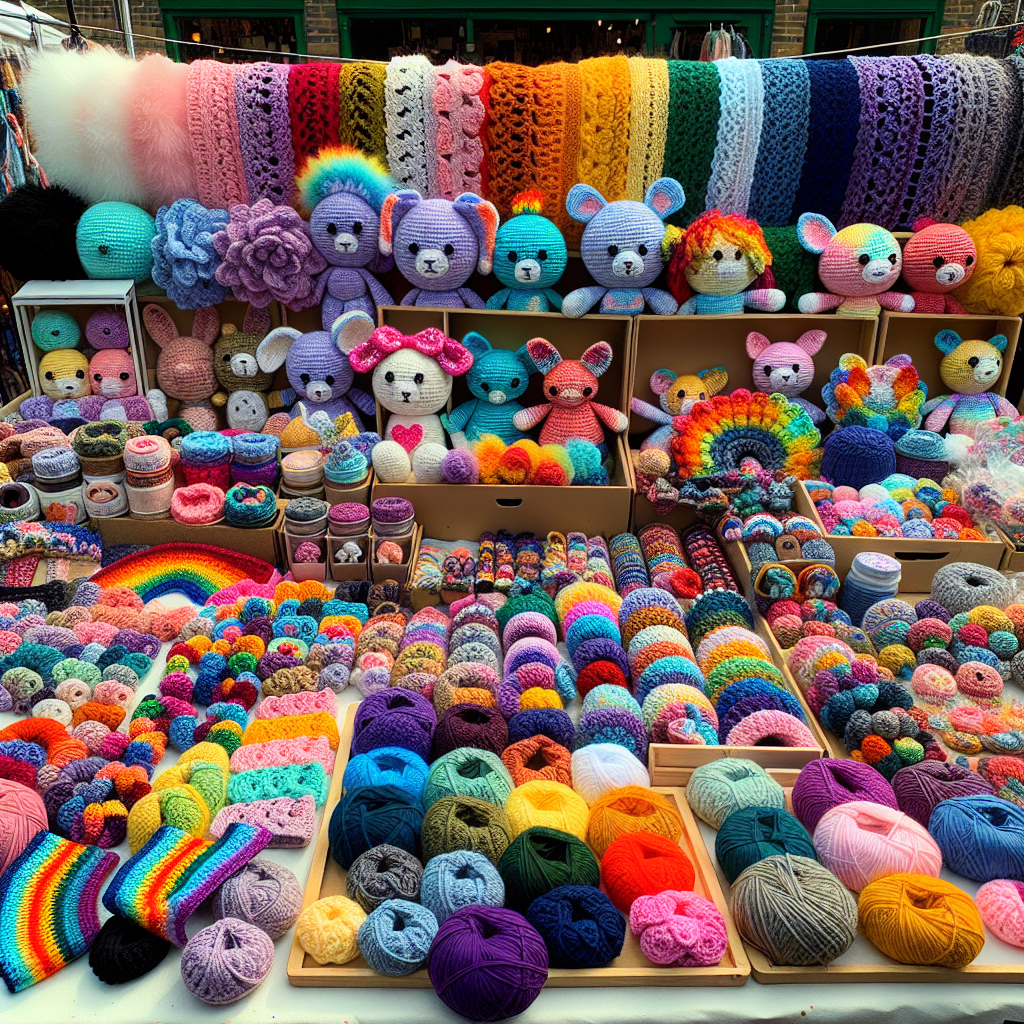Craft shows offer a fantastic opportunity to both make money and showcase your creative work. In a video by Andy Bird Builds, you can find valuable tips and strategies specifically tailored to selling woodworking projects at craft shows. The video takes you through the process of preparing for a craft show, sharing the results, and highlighting the key factors that contributed to their success. With over 200 items in inventory, their goal was to sell $500 worth of products. However, they managed to exceed expectations by making 27 sales and generating a total revenue of $853. Their strategy of matching products to the clientele and creating a themed booth according to the fall festival greatly contributed to their sales. Additionally, they found accepting credit cards and engaging in conversations with every shopper to be crucial to their success.
Craft Shows: A Great Way to Make Money and Showcase Your Work
Craft shows can be a great way to make some money and showcase your work. Whether you’re an artisan, a woodworker, or a creator of handmade products, participating in craft shows can offer numerous benefits. In this comprehensive article, we will discuss the advantages of participating in craft shows, how to effectively prepare for these events, strategies for success, and the key takeaways from a recent craft show. So let’s dive in and discover how craft shows can help you grow your business and connect with potential customers!
Benefits of Participating in Craft Shows
Craft shows provide an excellent opportunity to make money by selling your products directly to customers. Whether you have an online presence or a physical store, craft shows allow you to reach a different audience and generate immediate sales. By showcasing your work at these events, you can attract customers who appreciate handmade items and are willing to support local artisans.
In addition to making money, craft shows offer a platform to effectively showcase and promote your work. Customers attending these events are often specifically seeking unique, handcrafted items, which means you have a captive audience interested in what you have to offer. Craft shows provide a space for you to display your products and engage with potential customers, allowing them to see and experience the quality and craftsmanship of your work firsthand.
Furthermore, craft shows provide an opportunity to connect with potential customers on a personal level. Unlike online sales, where interactions are often limited to a few messages or emails, craft shows allow you to have face-to-face conversations with customers. This interaction not only helps build relationships but also allows you to understand their needs, preferences, and feedback. Such insights can be valuable for refining your products and improving your overall business strategy.
Craft shows also enable you to build brand awareness among a targeted audience. By participating in these events, you can establish your brand identity and create a positive impression in the minds of potential customers. The more people become familiar with your brand and recognize the quality of your work, the more likely they are to seek out your products in the future.
Preparing for a Craft Show
To make the most of your participation in craft shows, it is crucial to prepare adequately. Here are some key steps to consider when preparing for a craft show:
-
Selecting the right inventory: Choose products that appeal to the target audience of the craft show. Consider the theme and purpose of the event, and ensure your inventory aligns with the preferences and needs of potential customers attending the show.
-
Pricing products: Price your products appropriately based on their quality, uniqueness, and the effort put into creating them. Consider the market value and the level of competition at the craft show to find the right balance between profitability and attracting customers.
-
Organizing and packaging items: Display your products in an organized and visually appealing manner. Invest in quality packaging materials that enhance the overall presentation of your items and protect them during transportation and handling.
-
Creating an appealing booth setup: Design an eye-catching booth that reflects your brand identity and captures the attention of passersby. Consider using attractive signage, well-coordinated colors, and props that showcase your products in an appealing way.
-
Accepting credit cards: In today’s digital age, it is essential to offer multiple payment options to customers. Setting up a system to accept credit cards can significantly increase sales, as customers are more likely to make impulsive purchases when they have the convenience of paying with cards.
-
Promoting the event: Utilize various marketing channels to spread the word about the craft show and your participation in it. Leverage social media platforms, your website, and local advertising to create anticipation and generate interest among potential customers.
Strategies for Success at Craft Shows
Craft shows can be highly competitive, with numerous vendors vying for customers’ attention. To maximize your sales and stand out from the crowd, consider implementing the following strategies:
-
Matching products to the clientele: Thoroughly understand the demographics and preferences of the craft show attendees. Tailor your product selection to meet their specific needs and tastes, ensuring there is a strong alignment between your products and the interests of potential customers.
-
Getting products in front of the ideal customer: Strategically position your products within your booth to catch the attention of the target audience. Place your bestselling or most visually appealing items at eye-level or in prime locations to attract customers and pique their curiosity.
-
Setting sales goals: Establish clear sales goals for the craft show. By having a specific target in mind, you can focus your efforts, track your progress, and evaluate the success of your participation. Goals can vary based on factors such as revenue, the number of products sold, or the acquisition of new customers.
-
Utilizing effective pricing strategies: Experiment with different pricing strategies to find the sweet spot that maximizes sales while maintaining profitability. Consider using psychological pricing techniques, such as offering discounts for multiple purchases or setting an anchor price for high-value items.
-
Using visuals to help customers visualize: Use photographs or visual aids, such as mock setups or lifestyle images, to help customers envision how your products would look in their own homes or lives. Visual representations can create a stronger emotional connection and encourage customers to make a purchase.
-
Engaging with shoppers and showing interest: Actively engage with customers by initiating conversations, answering questions, and showing genuine interest in their needs. Personal connections can build trust and increase the likelihood of a sale while creating a positive impression of your brand.
-
Investing in booth setup and aesthetics: Allocate resources to create an appealing booth setup that reflects the quality and uniqueness of your products. Consider using attractive displays, well-designed banners, and creative lighting to create a visually appealing space that captivates customers.
-
Theming booth and products according to the event: Customize your booth and products to align with the theme or season of the craft show. Incorporate elements that resonate with the event’s atmosphere, such as using festive decorations or incorporating seasonal colors to enhance the overall appeal and entice customers.
Results and Key Takeaways
To provide practical insights, we will now share the results and key takeaways from a recent craft show. In this particular event, the goal was to sell $500 worth of products, with over 200 items in inventory. Here are the noteworthy outcomes and takeaways:
-
Sales results: A total of 27 sales were made during the craft show, generating $853 in revenue. This result exceeded the initial goal and highlighted the effectiveness of the strategies employed.
-
Best-selling and least successful products: The best-selling product was lanterns, with 24 out of 50 items sold. On the other hand, pumpkin trays were the least successful, failing to generate any interest, even after a price reduction.
-
Significance of multiple purchases: Multiple purchases were a significant contributor to the overall sales success. By offering incentives or discounts for multiple items, customers were encouraged to buy more and increase the average transaction value.
-
Effectiveness of offering fall and winter items: The craft show’s fall festival theme worked in favor of selling fall-related items. The Leaf Lanterns, specifically designed for the season, proved to be a popular choice among customers.
-
Factors contributing to success: The success of the craft show can be attributed to a combination of factors, such as matching products to the target audience, engagement with customers, competitive pricing, and creating an appealing booth setup.
-
Role of accepting credit cards: Accepting credit cards played a crucial role, accounting for $572 of the total sales. By providing customers with the convenience of various payment options, the barriers to purchase were lowered, leading to increased sales.
-
Importance of anchoring prices: Setting an anchor price, such as pricing a large flower at $300, helped establish a perception of value for other items in the booth. Customers were more willing to make purchases, even at higher price points, as they perceived the value based on the anchor item.
-
Utilizing visual aids for customer engagement: The use of pictures and visual aids helped customers visualize how the products would fit into their lives or homes. This visual engagement increased their desire to own the products and resulted in higher sales conversion rates.
-
Enhancing booth setup and aesthetics: The investment in creating an appealing booth setup, including rustic crates, themed tablecloths, and well-coordinated displays, grabbed customers’ attention and created a memorable experience. The aesthetics of the booth played a significant role in attracting potential customers.
-
Themed booth and product alignment with the event: Aligning booth decorations and product designs with the fall festival theme increased the overall appeal and sales potential. The cohesive visual presentation resonated with customers attending the event and increased their interest in making purchases.
Conclusion
In conclusion, participating in craft shows offers numerous benefits for artisans and creators. These events provide an opportunity to make money, showcase your work, connect with potential customers, and gain valuable insights and feedback. By adequately preparing for craft shows, utilizing effective strategies, and learning from the results, you can continue to grow your business and achieve success in the craft show industry. So, seize the opportunity, plan your next craft show participation, and continue to share your passion and creative work with the world!


